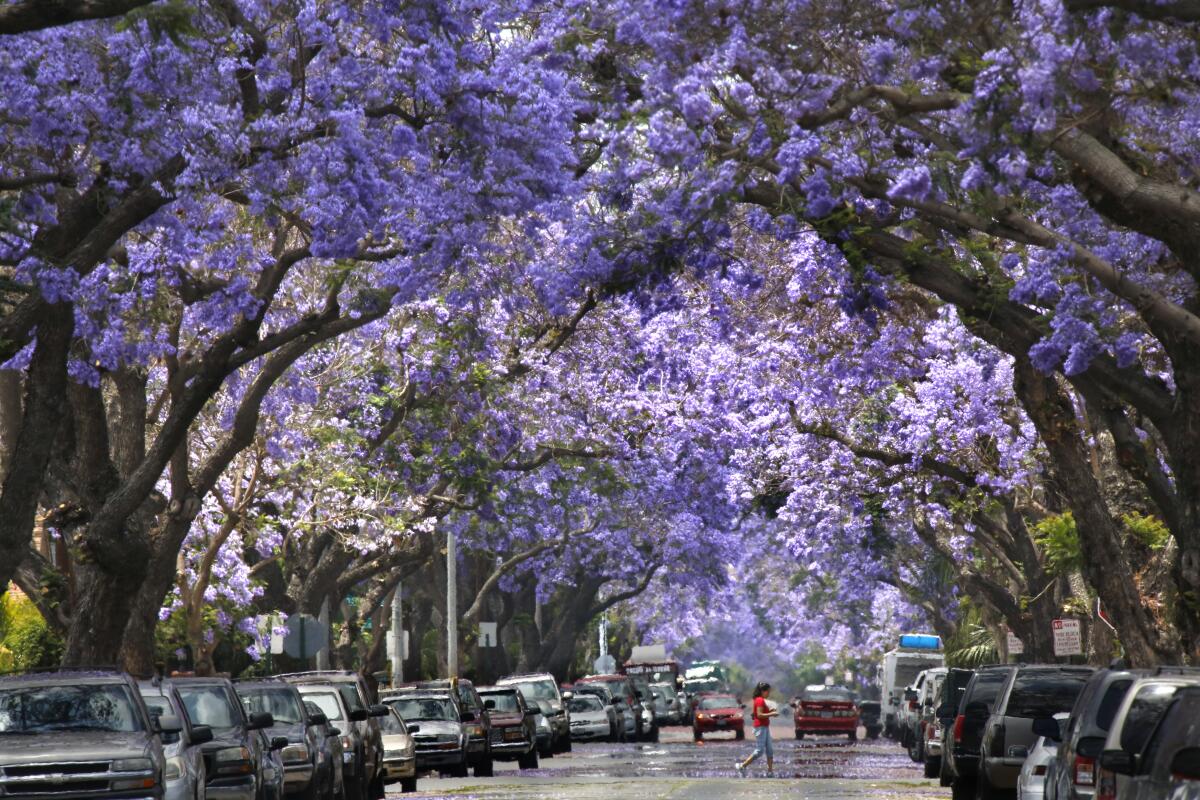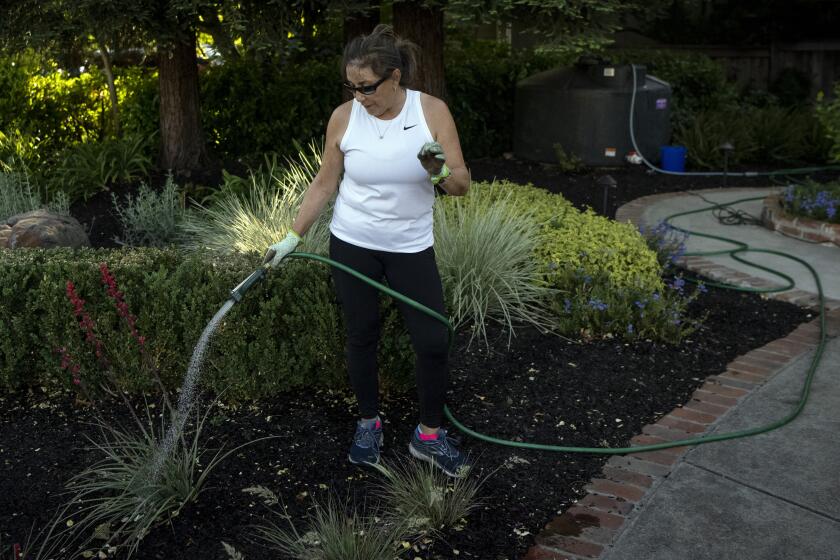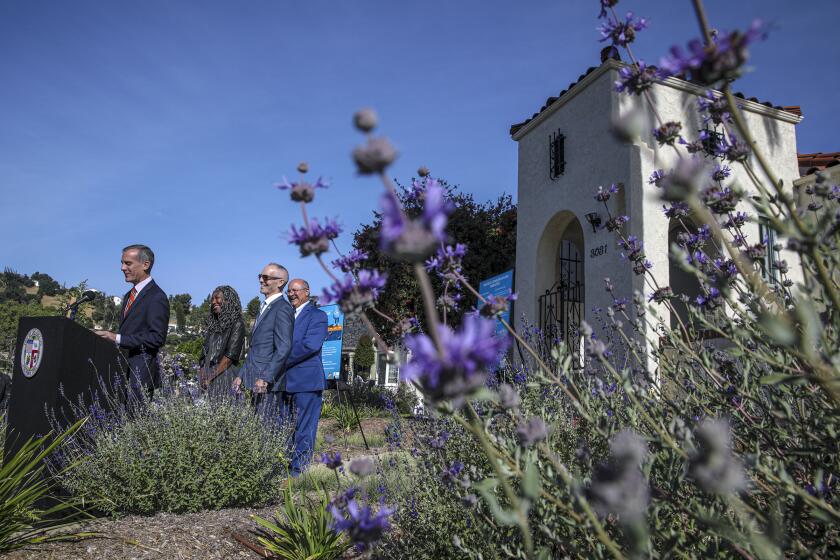The unofficial tree of Los Angeles reigns again

- Share via
There’s a jacaranda tree I pass when I walk in the mornings. I noticed it first a few years ago when it was in full flower. Now I keep an eye out for its blossoms. All through the winter and into the spring, I watch for those first wisps of color, thrill at the purple profusion of the tree in bloom.
It’s like meeting up with an old friend after a long absence.
Jacaranda season is my favorite time of year in Los Angeles. It was jacaranda season when I moved to the city, and simply to catch sight of those trees, with their lavender coronas, feels akin to coming home.
Like me, the jacarandas are transplants. Like me, they have settled in. First brought to California during the 19th century, they were popularized through the efforts of botanist Kate Sessions, who introduced more than 100 species of flora to the state. Nearly a century and a half later, there are 20,000 jacarandas in Los Angeles alone.
As parts of Southern California fall under new water restrictions, other regions offer lessons in how to shrink water use and adapt to drier times.
What this means is that when we revel in the radiance of the jacaranda, we are also reveling in the ways we have remade our environment.
Remaking our environment, of course, is a way of life in Southern California. As far back as 1876, when the construction of a spur line connecting the region to the transcontinental railroad helped to create Los Angeles’ post-pueblo ambitions, we have regarded this place as less fixed than fluid, a template for the landscapes we imagine, the lives we seek to invent.
Often these inventions carry treacherous legacies of avarice and race. The first Los Angeles Aqueduct — “There it is. Take it,” William Mulholland uttered when water first poured down the Sylmar cascades on Nov. 5, 1913 — benefited no one so much as the consortium of local leaders who’d bought up swaths of San Fernando Valley land at low prices, tipped off by inside information about the water project. Half a century later, the development of the freeway system effectively walled off South and East Los Angeles, enforcing de facto segregation on the city.
There’s no denying the impact such “progress” has had on what Los Angeles, physically and psychically, became. With the arrival, for example, of the aqueduct — which diverted water from the Owens River Valley, decimating Owens Lake — Los Angeles began to assume its amorphous sprawl, gobbling up Hollywood, the Valley and Westgate between 1910 and 1916.
Money, real estate and water: the city’s holy trinity.
The greening, or purpling, of Los Angeles also involves these elements, but mostly water. Jacarandas are everywhere, but they are especially abundant in Mid-Wilshire and along the placid streets of the Westside. These subtropical natives litter the sidewalks with their blooms and require deep watering in spring and summer, when, even in the best of times, Southern California becomes a “land of little rain,” to borrow a phrase from Mary Hunter Austin.
As California drought worsens, the DWP in Los Angeles will limit outdoor watering to two days a week, with watering capped at eight minutes per station.
These, of course, are not the best of times. After three years of drought, the Metropolitan Water District announced sweeping restrictions on nonessential water use, and the Los Angeles Department of Water and Power limited Angelenos to watering two days a week. “With this historic drought getting worse,” MWD General Manager Adel Hagekhalil said, “we cannot afford green lawns.”
Of course we can’t. And yet, what about the jacarandas? While they may have been transplants initially, they have come to represent for me an essential emblem of Los Angeles, a signal of nature’s cycles of renewal. They refute the notion that there are no seasons here, that Los Angeles keeps nature at bay. (On the contrary: I have never lived in a city so enmeshed with nature, from the massed brilliance of bougainvillea and the scent of night-blooming jasmine to more elemental processes — this drought, for one, and fires, mudslides and earthquakes — that remind us our relationship with this landscape is as tenuous as it is consequential.)
I want to say I gasped as I encountered the jacaranda blooms this season, but when they finally exploded into color I was not so much amazed as reassured. We are living, after all, through a dangerous period in which, as William Butler Yeats once wrote, “The best lack all conviction, while the worst / Are full of passionate intensity.” A tree isn’t going to affect that, but it can offer consolation — or perspective — nonetheless.
We exist, like the jacaranda, in a constant state of becoming. Good to remember in times like these.
David L. Ulin is a contributing writer to Opinion.
More to Read
A cure for the common opinion
Get thought-provoking perspectives with our weekly newsletter.
You may occasionally receive promotional content from the Los Angeles Times.











